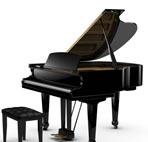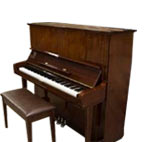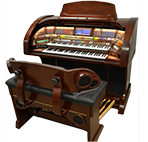Born: Vienna, 31 Jan 1797
Died: Vienna, 19 Nov 1828
The son of a schoolmaster, he showed an extraordinary childhood aptitude for music, studying the piano, violin, organ, singing and harmony and, while a chorister in the imperial court chapel, composition with Salieri (1808-13). By 1814 he had produced piano pieces, settings of Schiller and Metastasio, string quartets, his first symphony and a three-act opera. Although family pressure dictated that he teach in his father’s school, he continued to compose prolifically; his huge output of 1814-15 includes “Gretchen am Spinnrade” and “Erlkänig” (both famous for their text-painting) among numerous songs, besides two more symphonies, three masses and four stage works. From this time he enjoyed the companionship of several friends, especially Josef von Spaun, the poet Johann Mayrhofer and the law student Franz von Schober. Frequently gathering for domestic evenings of Schubert’s music (later called “Schubertiads”), this group more than represented the new phenomenon of an educated, musically aware middle class: it gave him an appreciative audience and influential contacts (notably the Sonnleithners and the baritone J. M. Vogl), as well as the confidence, in 1818, to break with schoolteaching. More songs poured out, including “Der Wanderer” and “Die Forelle,” and instrumental pieces – inventive piano sonatas, some tuneful, Rossinian overtures, the Fifth and Sixth Symphonies – began to show increased harmonic subtlety. He worked briefly as music master to the Esterházy family, finding greater satisfaction writing songs, chamber music (especially the “Trout” Quintet) and dramatic music. “Die Zwillingsbrüder” (for Vogl) was only a small success, but brought some recognition and led to the greater challenge of “Die Zauberharfe.”
In 1820-21 aristocratic patronage, further introductions and new friendships augured well. Schubert’s admirers issued 20 of his songs by private subscription, and he and Schober collaborated on “Alfonso und Estrella” (later said to be his favourite opera). Though full of outstanding music, it was rejected. Strained friendships, pressing financial need and serious illness – Schubert almost certainly contracted syphilis in late 1822 – made this a dark period, which however encompassed some remarkable creative work: the epic “Wanderer” Fantasy for piano, the passionate, two-movement Eighth Symphony (“Unfinished”), the exquisite “Schöne Müllerin” song cycle, “Die Verschworenen” and the opera “Fierabras” (full of haunting music if dramatically ineffective). In 1824 he turned to instrumental forms, producing the A minor and D minor (“Death and the Maiden”) string quartets and the lyrically expansive Octet for wind and strings; around this time he at least sketched, probably at Gmunden in summer 1825, the “Great” C major Symphony. With his reputation in Vienna steadily growing (his concerts with Vogl were renowned, and by 1825 he was negotiating with four publishers), Schubert now entered a more assured phase. He wrote mature piano sonatas, notably the one in A minor, some magnificent songs and his last, highly characteristic String Quartet, in G. 1827-8 saw not only the production of “Winterreise” and two piano trios but a marked increase in press coverage of his music; and he was elected to the Vienna Gesellschaft der Musikfreunde. But though he gave a full-scale public concert in March 1828 and worked diligently to satisfy publishers – composing some of his greatest music in his last year, despite failing health – appreciation remained limited. At his death, aged 31, he was mourned not only for his achievement but for “still fairer hopes.”
Schubert’s fame was long limited to that of a songwriter, since the bulk of his large output was not even published, and some not even performed, until the late 19th century. Yet, beginning with the Fifth Symphony and the “Trout” Quintet, he produced major instrumental masterpieces. These are marked by an intense lyricism (often suggesting a mood of near-pathos), a spontaneous chromatic modulation that is surprising to the ear yet clearly purposeful and often beguilingly expressive, and, not least, an imagination that creates its own formal structures. His way with sonata form, whether in an unorthodox choice of key for secondary material (Symphony in B minor, “Trout” Quintet) or of subsidiary ideas for the development, makes clear his maturity and individuality. The virtuoso “Wanderer” Fantasy is equally impressive in its structure and use of cyclic form, while the String Quartet in G explores striking new sonorities and by extension an emotional range of a violence new to the medium. The greatest of his chamber works however is acknowledged to be the String Quintet in C, with its rich sonorities, its intensity and its lyricism, and in the slow movement depth of feeling engendered by the sustained outer sections (with their insistent yet varied and suggestive accompanying figures) embracing a central impassioned section in F minor. Among the piano sonatas, the last three, particularly the noble and spacious one in B-flat, represent another summit of achievement. His greatest orchestral masterpiece is the “Great” C major Symphony, with its remarkable formal synthesis, striking rhythmic vitality, felicitous orchestration and sheer lyric beauty.
Schubert never abandoned his ambition to write a successful opera. Much of the music is of high quality (especially in “Alfonso und Estrella,” “Fierabras” and the attractive Easter oratorio “Lazarus,” closely related to the operas), showing individuality of style in both accompanied recitative and orchestral colour if little sense of dramatic progress. Among the choral works, the partsongs and the masses rely on homophonic texture and bold harmonic shifts for their effect; the masses in A-flat and E-flat are particularly successful.
Schubert effectively established the German lied as a new art form in the 19th century. He was helped by the late 18th-century outburst of lyric poetry and the new possibilities for picturesque accompaniment offered by the piano, but his own genius is by far the most important factor. The songs fall into four main structural groups – simple strophic, modified strophic, through-composed (e.g. “Die junge Nonne”) and the “scena” type (“Der Wanderer”); the poets range from Goethe, Schiller and Heine to Schubert’s own versifying friends. Reasons for their abiding popularity rest not only in the direct appeal of Schubert’s melody and the general attractiveness of his idiom but also in his unfailing ability to capture musically both the spirit of a poem and much of its external detail. He uses harmony to represent emotional change (passing from minor to major, magically shifting to a 3rd related key, tenuously resolving a diminished 7th, inflecting a final strophe to press home its climax) and accompaniment figuration to illustrate poetic images (moving water, shimmering stars, a church bell). With such resources he found innumerable ways to illuminate a text, from the opening depiction of morning in “Ganymed” to the leaps of anguish in “Der Doppelgänger.”
Schubert’s discovery of Wilhelm Müller’s narrative lyrics gave rise to his further development of the lied by means of the song cycle. Again, his two masterpieces were practically without precedent and have never been surpassed. Both identify nature with human suffering, “Die schöne Müllerin” evoking a pastoral sound-language of walking, flowing and flowering, and “Winterreise” a more intensely Romantic, universal, profoundly tragic quality.











